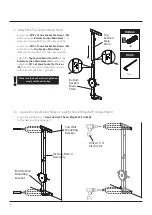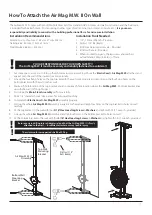
Always consult your doctor
before undertaking a new
exercise regime
If you experience nausea, dizziness or other abnormal
symptoms during exercise, stop at once and consult
your doctor
!
Correct skiing form
•
Begin with your hands shoulder-width apart and slightly
above your head. Your arms should be bent.
Your feet should be shoulder-width apart.
•
Drive the handles downward by engaging your core
abdominal muscles and bending your knees.
Maintain the bend in your arms to keep the handles
fairly close to your face.
•
Finish the drive with knees slightly bent, and arms
extended down alongside your thighs.
•
Bring your arms back up and straighten your legs.
•
Extend your arms upward and straighten your body to
return to the start position.
How long should I exercise for?
That really depends on your current level of fitness. If you’re
just starting out on a new exercise program, you should
start gradually and build up – do not try to do too much too
quickly. 30 minutes, 3 times a week should be enough.
Don’t push yourself too hard - you should never feel
exhausted during or following exercise.
Heart Rate Training
To get the most out of your new piece of fitness equipment
and see the best results from your training you should exercise
at the right level of effort, and that means listening to your
heart! Working out to a target heart rate means you can
direct your workout to achieve different goals:
Good health
- For those wishing to improve quality of life
and general well being. Your sessions will need to be
done at an intensity of between 50-60% of your estimated
maximum heart rate, should last about 30 minutes and can
be done on most days of the week.
Weight loss
– To see a significant reduction in body fat, your
sessions must be a little more intense - between 60 and
70% of your estimated maximum heart rate. These sessions
can also be performed on most days of the week for up to
30 minutes.
Improving Fitness levels
–These sessions should be
performed at 70-80% of your estimated maximum heart
rate and can also involve bouts of interval training that
would have your heart rate peaking for short times near
your maximum heart rate level. These are intense sessions
and will require at least a 48 hour rest between sessions.
Calculating your target heart rate
First, you need to find your estimated maximum heart rate
using the formula ‘220 minus your age in years’. So, if you are
35 years old your estimated maximum heart rate is:
220 – 35 = 185 beats per minute (bpm)
Next, to calculate your target heart rate, simply multiply your
estimated maximum heart rate (185 bpm) by the applicable
percentage. So, if your goal is better heath:
185 x 60% = 111 bpm
NOTE: The important issue to remember with all
estimated calculations is that they are just estimates –
if you don’t feel comfortable exercising at your target
then reduce it to a level you are comfortable with.
!
Note:
Heart rate training requires you to monitor your heart
rate throughout the workout. For this we recommend using a
chest strap (if your machine has a wireless receiver) or a heart
rate monitor.
Starting and finishing your workout
Begin and end each workout with a Warm Up / Cool Down session – a few minutes of stretching to help prevent strains,
pulls and cramps
21




































